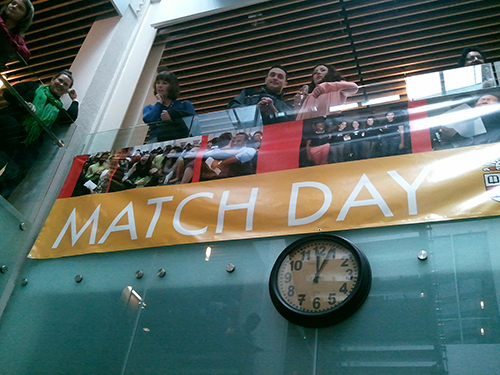
Medical students work exceptionally hard to match to a residency program. They celebrate their placements on Match Day every March.
David Orenstein
PROVIDENCE, R.I. [Brown University] — For people with a greater than 50 percent chance of landing their top job choice and a greater than 90 percent chance of getting a job in their field, would it seem like overkill for each of them to apply for more than 40 jobs?
That’s exactly what’s happening every year among U.S. students receiving M.D. degrees. The highly successful process of matching medical graduates to residencies has nevertheless become so frenzied that the authors of a new article in Academic Medicine explicitly question the rationality of the system. It’s driving up costs for students and severely disrupting the fourth year of medical school, they say.
“There’s been this inexorable intensification of the residency selection process such that it’s basically taken over the fourth year of medical school,” said Dr. Phil Gruppuso, a professor of pediatrics in the Warren Alpert Medical School of Brown University and a former associate dean for medical education. “It so dominates student time and energy during the fourth year that it’s become very difficult to do any curriculum planning.”
Gruppuso recalls that he pursued only four pediatrics residency programs back in the 1970s. The statistics he uncovered with co-author Dr. Eli Adashi, former dean of medicine and biologic sciences at Brown, show that by 2005, students across the country were applying on average to 30.3 programs. In 2015 the number reached 45.7. For specialties deemed highly competitive, the numbers go even higher: The average student hoping to be an orthopedic surgeon, for example, applied to 73 of the 163 potential programs.
The surge of residency program applications appears to derive from a perception among students that it’s necessary to ensure placement in a top program. Indeed, among all applicants to residency programs, the number of offers per applicant fell to 0.78 in 2015 from 0.96 in 1976.
But that decrease doesn’t affect graduates of U.S. allopathic medical schools (those that award M.D. degrees). Instead the decrease has emerged as other kinds of students — most notably graduates of osteopathic or foreign medical schools — have increasingly joined the fray, Adashi and Gruppuso found.
Among M.D. graduates in the U.S., the number of offers per applicant has actually increased to 1.51 in 2015 from 1.37 in 1976. Moreover, between 92 and 95 percent of those graduates have successfully matched every year since 1982, the authors note, and since 1997 the chance of students matching to their top choice has remained between 50 and 60 percent.
“At the end of the day, if you are a U.S. medical school graduate, you are virtually assured of getting a job,” Gruppuso said. “There’s an irrationality about it that is different than when most people are looking for a job and are running the risk of not finding one.”
Disruptive, costly and maybe unfair
After students file their (many, many) applications electronically, programs invite their preferred students for interviews. Here Gruppuso and Adashi could find no national data, but a survey of fourth-year students at the Alpert Medical School suggests that the number of interviews has scaled up with the number of applications. That means that students are on the road for substantial chunks of time throughout their fourth year of school. Interviews among programs and disciplines are not coordinated, making it hard for faculty members to plan a curriculum in which students can fully participate.
Meanwhile, Gruppuso and Adashi wrote, the financial burden of traveling to many interviews around the country may significantly disadvantage students of low socioeconomic status, though that’s never been formally studied. Furthermore, as overwhelmed residency, or graduate medical education (GME), programs sort through huge volumes of applications, they may rely more on test scores and less on more qualitative indicators of candidate suitability.
“Should this occur, it could have a detrimental effect on the ability of GME programs to achieve diversity by reducing the selection of students from disadvantaged educational backgrounds who may be at risk for underperformance on standardized examinations,” the authors wrote.
Data, solutions needed
More than anything, Gruppuso and Adashi call for more data so that medical educators can either prove or disprove the “more is better” hypothesis that students appear to have accepted as a new normal. It may be that scores of applications are truly necessary, but it also may be that students are routinely going far past the point of diminishing returns.
Gruppuso and Adashi also propose a few steps that medical education organizations such as the National Residency Matching Program, the Association of American of Medical Colleges and the American Medical Association could take to treat what they call the “Residency Placement Fever.”
- Coordinate interview timing: If student interviews could be consolidated into a predictable, cohesive season, educators could plan a meaningfully educational curriculum for the rest of the fourth year.
- Reduce or cap the number of interviews: If students could only take on a maximum of 10 interviews, they might be more thoughtful and selective about where they sent applications.
- A “screen and schedule” system: If residency programs employed online screening interviews before inviting applications in person, that could reduce unnecessary time and travel for students who don’t become finalists.
Adashi and Gruppuso readily acknowledge these particular ideas might not take hold, but they argue it’s certainly time for an examination of whether the current state of residency applications makes sense.
“In the end what we’re saying is there really ought to be some thought given to this and some data collected,” Gruppuso said. “There are no easy solutions.”